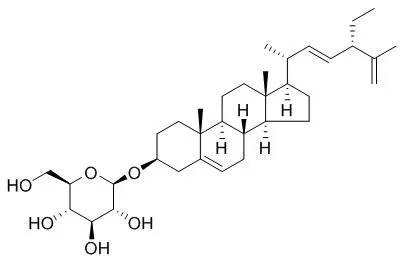| Structure Identification: |
| Lipids, 2000, 35(3):279-288. | | Biosynthesis of sterols and ecdysteroids in Ajuga hairy roots.[Reference: WebLink] | Hairy roots of Ajuga reptans var. atropurpurea produce clerosterol, 22-dehydroclerosterol(22-Dehydroclerosterol glucoside
), and cholesterol as sterol constituents, and 20-hydroxyecdysone, cyasterone, isocyasterone, and 29-norcyasterone as ecdysteroid constituents. To better understand the biosynthesis of these steroidal compounds, we carried out feeding studies of variously 2H- and 13C-labeled sterol substrates with Ajuga hairy roots. In this article, we review our studies in this field.
METHODS AND RESULTS:
Feeding of labeled desmosterols, 24-methylenecholesterol, and 13C2-acetate established the mechanism of the biosynthesis of the two C29-sterols and a newly accumulated codisterol, including the metabolic correlation of C-26 and C-27 methyl groups. In Ajuga hairy roots, 3α-, 4α-, and 4β-hydrogens of cholesterol were all retained at their original positions after conversion into 20-hydroxyecdysone, in contrast to the observations in a fern and an insect. Furthermore, the origin of 5β-H of 20-hydroxyecdysone was found to be C-6 hydrogen of cholesterol exclusively, which is inconsistent with the results in the fern and the insect. These data strongly support the intermediacy of 7-dehydrocholesterol 5α,6α-epoxide. Moreover, 7-dehydrocholesterol, 3β-hydroxy-5β-cholest-7-en-6-one (5β-ketol), and 3β,14α-dihydroxy-5β-cholest-7-en-6-one (5β-ketodiol) were converted into 20-hydroxyecdysone. Thus, the pathway cholesterol→7-dehydrocholesterol→7-dehydrocholesterol 5α,6α-epoxide→5β-ketol→5β-ketodiol is proposed for the early stages of 20-hydroxyecdysone biosynthesis. 3β-Hydroxy-5β-cholestan-6-one was also incorporated into 20-hydroxyecdysone, suggesting that the introduction of a 7-ene function is not necessarily next to cholesterol. C-25 Hydroxylation during 20-hydroxyecdysone biosynthesis was found to proceed with ca. 70% retention and 30% inversion.
CONCLUSIONS:
Finally, clerosterol was shown to be a precursor of cyasterone and isocyasterone. |
|






 Cell. 2018 Jan 11;172(1-2):249-261.e12. doi: 10.1016/j.cell.2017.12.019.IF=36.216(2019)
Cell. 2018 Jan 11;172(1-2):249-261.e12. doi: 10.1016/j.cell.2017.12.019.IF=36.216(2019) Cell Metab. 2020 Mar 3;31(3):534-548.e5. doi: 10.1016/j.cmet.2020.01.002.IF=22.415(2019)
Cell Metab. 2020 Mar 3;31(3):534-548.e5. doi: 10.1016/j.cmet.2020.01.002.IF=22.415(2019) Mol Cell. 2017 Nov 16;68(4):673-685.e6. doi: 10.1016/j.molcel.2017.10.022.IF=14.548(2019)
Mol Cell. 2017 Nov 16;68(4):673-685.e6. doi: 10.1016/j.molcel.2017.10.022.IF=14.548(2019)